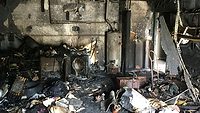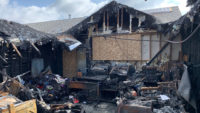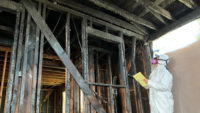Mastering Fire Restoration Estimation Part 4

All photos in this article are the courtesy of Sean Scott
This is the third article in a series on estimating fire restoration jobs. Did you miss previous parts?
Mastering Fire Restoration Estimation Part 1
Mastering Fire Restoration Estimation Part 2
Mastering Fire Restoration Estimation Part 3
Estimating General Items and Conditions
The final phase of writing an estimate on a residential or commercial fire is compiling all the items and/or tasks that may not be attributed to a specific room, elevation, or area of the building. These items are typically put in their own category commonly known as the general items or general conditions. I often separate certain elements of the scope of work into their own headings for things like building code upgrades, mold remediation, debris removal, landscaping, or fencing since these items often have their own specific insurance coverage limits. Breaking out these types of repairs separately also makes the adjuster’s job easier as they can categorize them and apply the appropriate coverage amounts.
Building code upgrade related items:
This is one area where restorers need to pay close attention as coverage for code upgrades is often very low and yet the costs can be very high. Code upgrade related items do not necessarily apply to direct damage from a fire but pertain to any additional costs required by local jurisdictions or building officials to upgrade buildings to comply with current construction standards. This may include things as simple as adding smoke detectors in bedrooms where none may have existed prior to the fire to much more costly upgrades such as retrofitting foundations to support new loads, upgrading entire electrical systems and panels, replacing windows for energy conservation, adding sheer panel and hardware to increase earthquake or wind resistance, upgrading exterior components to resist wildfires, etc. One of the worst-case scenarios I have encountered is when buildings built in the late 1800s or early 1900s have minimal fire damage, but have to be torn down because of their poor and unsafe construction. In situations like this, although the fire damage may require minimal repairs, the cost to tear down and completely rebuild a building can run well into six figures.
NOTE: In the event the costs to upgrade a building to current code exceeds the policy limits, the insured may have to come out of pocket to cover the costs. If the insured doesn’t have the financial ability to cover these costs or is unwilling to pay for work needed, the restorer may have a tough time getting paid or face a major legal battle down the road. Estimators should try to determine what the code upgrade costs will be before signing a contract for repairs.
 Subcontractor, vendor, or material bids:
Subcontractor, vendor, or material bids:
This may include major trades that involve the entire structure such as demolition labor and debris removal costs, framing material, HVAC, electrical, plumbing, concrete or foundation work, structural steel, etc. Other costs may include interior designer fees, delivery charges, security or entertainment systems, exterior elements such as landscaping, irrigation, hardscape, fencing, etc.
Smoke odor control and remediation:
In this category you would want to detail the equipment and labor needed for odor control and remediation work. This may include the quantity of air scrubbers, heaters, or hydroxyl generators needed per day, engineering controls such as containments, HEPA filters, PPE, decontamination of equipment, etc.
Hazardous material abatement charges:
In this section, you might include a breakdown of any costs associated with asbestos, lead, mold, silica or other hazardous material abatement. This would include testing, labor to remove the material, disposal, equipment, clearance testing fees, etc.
Plans, permits, engineering fees:
Here you would provide the estimated breakdown of costs associated with having an architect draw plans to repair the structural components of the building. This section would also include costs for engineering, permit fees, special onsite inspections, etc.
Temporary services or equipment:
This section typically includes services or equipment needed on a temporary basis. These might include temporary security fencing, scaffolding, shoring, cranes or heavy equipment, generators, toilets, lighting, security guards, hand wash stations, etc.
 Warranty allowances:
Warranty allowances:
Some contractors charge a fee to cover warranty work. This can be done by adding a lump sum to the general items or adding a percentage to the overhead factor at the end of the estimate. Sooner or later something will go wrong on the job that will need to be fixed. Whether it’s smoke odor that returns, a pipe leaks under a cabinet, your guys scratched the floor when they moved the appliances, or a wide range of other issues, you can rest assured that you’ll be the one going back at your expense to handle it. In the event something major goes wrong, such as when a subcontractor performs defective work that causes a flood or a fire then skips town, the restoration contractor is on the hook.
Supervision and project management:
No matter how big or small the job may be, project management and supervisory time should be factored into your estimates. Some adjusters may argue that this should be included in your overhead, however most seasoned restorers will disagree. Here is an example of the language I have used in estimates that explains the need for supervision and project management time on a fire loss:
“Supervision and project management time is a direct job cost incurred and required for this project. This time is not included in the overhead and profit factors shown at the end of this estimate. For clarification of what is and what is not included in a contractor's overhead & profit, see Xactware's white paper that address this issue at: https://eservice.xactware.com/esc/html/o-n-p.htm
Supervision time includes but is not limited to:
- Time to meet with building inspectors on site for multiple inspections
- Time on site to coordinate subcontractors and workers
- Time on site to oversee the work and maintain safety standards and quality control
- Time on site to compile supplemental estimates and document conditions
- Time to meet with owner to select finishes
- Time on site to accept deliveries of materials
- Allowance of time for final walk through and punch list items
- Time on site for trouble shooting
This project will take approximately ____ weeks to complete. A supervisor will spend on average of one hour a day on site, 1.5 hours of travel to and from the project, and time at the office coordinating for a total of roughly 12 hours per week or ____ hours. In addition, when an inspection is needed during building repairs or to reestablish utilities, you are given a 4-hour window when the inspector may arrive, which means the supervisor has to wait up to four hours for each inspection. Some inspections do not pass the first time and require re-inspections. This project will require the following inspections: Foundation, rough framing, electrical, rough plumbing, roof nailing, insulation, drywall nailing, mechanical, exterior wrap, final inspection, etc. There will be approximately 12 inspections on this project, which will require additional time of 48 hours. The total supervisory time will be approximately ____ hours.”
Taking your time, documenting all the details, and being thorough are keys to writing accurate and profitable estimates. Knowledge is king, so never stop learning!
Looking for a reprint of this article?
From high-res PDFs to custom plaques, order your copy today!






